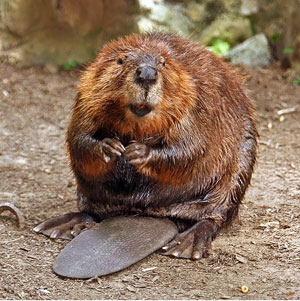
What did the beaver ever do to Senator Nicole Eaton to warrant such vicious name-calling? "Dentally defective rat" and "toothy tyrant" are just two of the taunts she flung at Castor canadensis in a statement in the Senate recently. And, to add injury to insult, she wants to fire this hard-working, long-serving Canadian symbol on the grounds that it is a "19th-century has-been" that "wreaks havoc" on the environment. It appears Ms. Eaton needs refresher courses in both history and biology.
It's true that the beaver nearly achieved has-been status at the end of the 19th century, but it once reigned as one of Canada's -- and indeed, North America's -- dominant species. Before Europeans arrived, beavers inhabited almost all of what we now call Canada and the United States, plus a sliver of Mexico. They ranged from coast to coast and from just south of the Rio Grande to the Mackenzie and Coppermine river deltas on the Arctic Ocean. As the explorer and mapmaker David Thompson put it, the northern half of the continent was once "in the possession of two distinct races of Beings, Man and the Beaver."
Estimates of North America's pre-contact beaver population range from 60 million to 400 million. Thanks to the fur trade, by the beginning of the 20th century their numbers were down to about 100,000 -- less than 0.2 per cent of the most conservative original figure. Canada was literally built on the backs of beavers. Since they had no choice in the matter, the least we can do is continue to honour their sacrifice.
However, the best argument against Ms. Eaton's proposed "emblem makeover" is based on the future, not the past. Her nominee for the new national symbol is the polar bear, which she characterizes as a "21st-century hero." Sadly, the polar bear is more of a 21st-century victim, a casualty of our rapidly warming climate. Beavers, on the other hand, are proving to be important allies in coping with two common effects of climate change: flooding and drought.
Can we all get along?
Although beavers are often denounced for causing inconvenient inundations, they deserve credit for preventing more flooding than they cause. Beaver dams create and enhance wetlands, and wetlands balance out extremes in water flow by retaining runoff during high flows and releasing it gradually. One American study found that the same volume of water that rushes down a beaver-less river corridor in 24 hours takes seven to 10 days to pass through territory inhabited by the four-legged dam-builders.
Beaver-created wetlands also recharge aquifers and increase the availability of water during dry periods. In one demonstration of this effect, researchers at the University of Alberta recently found that ponds with beavers had nine times more open water than those without. The difference was especially dramatic during drought years, when the beaver ponds remained replete, while some unoccupied sites became mudflats.
Beavers provide vital habitat for a multitude of birds, mammals, amphibians, reptiles, fish and insects, many of them threatened or endangered wetland dependents. And if heroes are what Ms. Eaton is looking for, how about the six beavers that lost their lives while their dam confined a 28,000-barrel oil spill in northern Alberta last spring?
Beaver populations have rebounded over the past century and the species is now returning to many places from which it was missing for decades or even centuries. Not surprisingly, this is causing conflict. No other non-human species shapes landscapes as profoundly as the beaver, and although we admire their engineering efforts in principle, the results don't always please us. But that's no reason to get rid of them, either literally or symbolically. Technological innovations such as "beaver bafflers," along with a spirit of compromise, can help us settle our differences peaceably and reap the benefits of having beavers as neighbours.
If we can't learn to respect and coexist with an animal as amiable and engaging as the beaver, I don't hold much hope for us solving bigger environmental challenges, such as how to save the polar bear. ![]()
Read more: Environment
















Tyee Commenting Guidelines
Comments that violate guidelines risk being deleted, and violations may result in a temporary or permanent user ban. Maintain the spirit of good conversation to stay in the discussion.
*Please note The Tyee is not a forum for spreading misinformation about COVID-19, denying its existence or minimizing its risk to public health.
Do:
Do not: